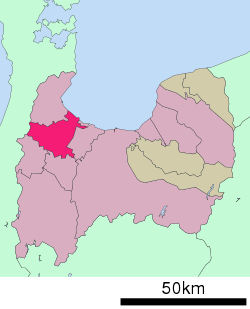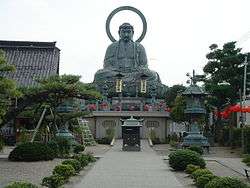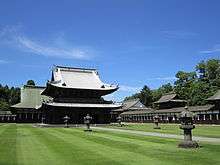Takaoka, Toyama
| Takaoka 高岡市 | ||
|---|---|---|
| City | ||
|
Clockwise from top, Sho River, Yakamochi Otomo's Stature in Takaoka Station, Takaoka Castle Site, Amahara Sea Coast, Takaoka Daibutsu, Otoko Rock in Takaoka Bay | ||
| ||
 Location of Takaoka in Toyama | ||
 Takaoka Location in Japan | ||
| Coordinates: 36°45′N 137°2′E / 36.750°N 137.033°ECoordinates: 36°45′N 137°2′E / 36.750°N 137.033°E | ||
| Country | Japan | |
| Region | Chūbu (Hokuriku) | |
| Prefecture | Toyama | |
| Government | ||
| • Mayor | Masaki Takahashi | |
| Area | ||
| • Total | 209.42 km2 (80.86 sq mi) | |
| Population (October 1, 2010) | ||
| • Total | 177,552 | |
| • Density | 847.99/km2 (2,196.3/sq mi) | |
| Symbols | ||
| • Tree | Koshinohigan-Sakura | |
| • Flower | Katakuri (Katakago) | |
| Time zone | Japan Standard Time (UTC+9) | |
| City hall address |
7-50 Hirokōji, Takaoka-shi, Toyama-ken 933-8601 | |
| Website |
www | |
Takaoka (高岡市 Takaoka-shi) is a city located in the northwestern portion of Toyama Prefecture, Japan, and is the central city of its Western District. Takaoka covers the 8th largest surface area in Toyama Prefecture and has the second largest population after Toyama City. Takaoka became a city on April 1, 1889, withdrawing from Imizu District.
History
.jpg)
Originally, the Takaoka region was called Sekino, but when Maeda Toshinaga opened the city in 1609, he named it after a verse from the religious poem Shihen which includes the word Takaoka. In addition to this, the fact that Takaoka Castle was built on a slightly elevated shoreline is thought to be another possible origin for the name Takaoka, since Taka means "high" and "Oka" means "hill or elevated land".
The present-day suburbs of Takaoka formed the provincial capital of the former Ecchu Province, and Ōtomo no Yakamochi took position as a government official in this area. During his five-year stay he wrote many waka poems. This is the reason for Takaoka being named Manyō City. Even today the main event at the annual Manyō Festival is the 20 Volume Manyō recital.
In 1609, when Maeda Toshinaga of the Kaga Domain entered Takaoka Castle, he officially opened the city of Takaoka. At the time of the opening of the city, it was reorganized for a population of less than 5,000 inhabitants and the Samurai Yashiki (residences) were positioned around the castle and towards the southern plateau.
However, in 1615, when an edict was passed that there was to be only one castle in each feudal domain, Takaoka castle was destroyed. At the time, people said that cities without castles would fall into decline however Maeda Toshinaga pursued policies regulating the relocation of Takaoka citizens and promoting the development of Takaoka as an industrial city. This resulted in the start of Takaoka’s role as a city of commerce and industry. Takaoka copperware and lacquerware also took off at this time.
More recently, on April 1, 1889, Takaoka was registered as one of Japan's first cities together with 30 cities nationwide, including Hirosaki in Aomori Prefecture.[1]
An Imperial decree in July 1899 established Fushiki Port (now known as Fushiki Toyama Port) as an open port for trading with the United States and the United Kingdom.[2]
On November 1, 2005, the town of Fukuoka (from Nishitonami District) was merged into Takaoka. Therefore, Nishitonami District was dissolved as a result of this merger.
Geography
Takaoka covers an area of 209.42 km2 (20,942ha), which equates to roughly 5% of the surface area of Toyama Prefecture. The surface area of the city comprises 36.96 km2 of real estate, 61.02 km2 of agricultural land, 22.69 km2 of mountains and forests, 80.43 km2 of public property (parks etc.), 6.10 km2 of wasteland, and 2.18 km2 of moorland.[3] The Takaoka region extends 19.2 km from north to south, 24.5 km from east to west with a perimeter of 125.9 km – which is roughly equal to the length of coastline in Toyama Prefecture (147 m). Takaoka borders four cities in Toyama Prefecture (Himi, Oyabe, Tonami, and Imizu) and two towns in Ishikawa Prefecture (Tsubata and Hondatsu Shimizu)
From its border with Himi down to the southwest area of the city, a range of mountains stretch for roughly 150 m to 300 m with a particularly high stretch of mountains centering on Mt. Futagami near Himi. Shogawa River and the Oyabegawa River run through Takaoka and tributaries weave their way though the city center. Including small rivers, a total of 10 rivers flow through the city. The Amaharashi coast lies to the north of the region. Just off the coast lies the island Otokoiwa. Another island, Onnaiwa, lies nearby and the view of this island against the backdrop of the Mount Tate range of peaks is famous and features in promotional media for the region.[4] A section of the Imizu plains runs from the central district of the city to the eastern district, and the Tonami plains which stretch from the West to the South are dotted with villages in certain areas.
Climate
The climate of Takaoka is a humid subtropical climate (Köppen climate classification Cfa), similar to that of much of the Japan Sea coast. All of the regions in Toyama Prefecture can experience large quantities of snow in winter. Depending on the year, the city can experience extraordinarily heavy snowfall, like, for example in 2006 when snow piled 1.4m high and in 2011 1.27m was recorded. According to weather records, the average temperature in 2010 was 14.5 °C, the average level of humidity was 79%, the yearly rainfall was roughly 2,665.5mm and there were 1,634 hours of sunlight.[5]
| Climate data for Fushiki, Takaoka, Toyama | |||||||||||||
|---|---|---|---|---|---|---|---|---|---|---|---|---|---|
| Month | Jan | Feb | Mar | Apr | May | Jun | Jul | Aug | Sep | Oct | Nov | Dec | Year |
| Average high °C (°F) | 5.3 (41.5) |
5.8 (42.4) |
9.8 (49.6) |
16.1 (61) |
20.8 (69.4) |
23.9 (75) |
28.4 (83.1) |
30.4 (86.7) |
25.9 (78.6) |
20.2 (68.4) |
14.8 (58.6) |
9.1 (48.4) |
17.54 (63.56) |
| Daily mean °C (°F) | 2.2 (36) |
2.4 (36.3) |
5.5 (41.9) |
11.4 (52.5) |
16.2 (61.2) |
20.2 (68.4) |
24.6 (76.3) |
26.3 (79.3) |
22.0 (71.6) |
16.0 (60.8) |
10.5 (50.9) |
5.4 (41.7) |
13.56 (56.41) |
| Average low °C (°F) | −0.4 (31.3) |
−0.5 (31.1) |
1.7 (35.1) |
7.0 (44.6) |
12.1 (53.8) |
17.2 (63) |
21.7 (71.1) |
22.9 (73.2) |
18.7 (65.7) |
12.2 (54) |
6.7 (44.1) |
2.2 (36) |
10.13 (50.25) |
| Average precipitation mm (inches) | 267.4 (10.528) |
178.3 (7.02) |
132.1 (5.201) |
119.2 (4.693) |
117.5 (4.626) |
187.7 (7.39) |
229.9 (9.051) |
168.8 (6.646) |
230.1 (9.059) |
167.7 (6.602) |
218.0 (8.583) |
266.1 (10.476) |
2,282.8 (89.875) |
| Average snowfall cm (inches) | 171 (67.3) |
118 (46.5) |
28 (11) |
1 (0.4) |
0 (0) |
0 (0) |
0 (0) |
0 (0) |
0 (0) |
0 (0) |
2 (0.8) |
59 (23.2) |
379 (149.2) |
| Average relative humidity (%) | 82 | 79 | 72 | 70 | 72 | 79 | 80 | 77 | 77 | 74 | 75 | 79 | 76.3 |
| Mean monthly sunshine hours | 57.0 | 73.8 | 134.4 | 174.0 | 206.0 | 156.1 | 167.7 | 201.1 | 135.1 | 138.5 | 96.8 | 64.3 | 1,604.8 |
| Source: NOAA (1961-1990)[6] | |||||||||||||
Transportation
Takaoka is served by JR West's Takaoka Station with the Hokuriku Main Line, the Himi Line, and the Jōhana Line. Within the city, Manyōsen's Shin-Minato Harbor and Takaoka Kidō lines offer transport.
Economy
The Yomiuri Shimbun newspaper has a branch office in Takaoka.
The Symbol of Takaoka
After Takaoka merged with Fukuoka Machi in 2005, the Merger Association and a selection board chose the current symbol from a selection of those entered by the public. The current symbol symbolizes the same character (高) with the colors green – to show the nature in Takaoka and Fukuoka, and blue - to show the abundant supply of water in the region.
The city has two mascots – Yakamochi-kun, a character based on the famous waka poet Otomo no Yakamochi and Toshinaga-kun, a character based on the city’s founder Maeda Toshinaga.
Foreign population
As of 2011, the Brazilian population of Takaoka stands at roughly 1,430, the Chinese population at roughly 700, and the Philippine population at roughly 360.[7]
International relations
Takaoka has three sister cities:
 Mirandópolis, São Paulo, Brazil
Mirandópolis, São Paulo, Brazil Fort Wayne, Indiana, United States
Fort Wayne, Indiana, United States Jinzhou, Liaoning, China
Jinzhou, Liaoning, China
Mirandópolis is situated roughly 600 km northwest of São Paulo, Brazil. The sister city relationship with Takaoka was initiated in 1974 and since then a variety of exchange activities have taken place including the Junior Goodwill Ambassador Exchange Program. Mirandopolis is also home to the Takaoka Japanese School where, since 1993, teachers have been sent to teach Japanese to the Brazilian-Japanese community living there.
Fort Wayne is the second largest city in Indiana after Indianapolis. It has been a sister city with Takaoka since 1977.
Takaoka has been sister cities with Jinzhou in China since 1985.
Takaoka also shares a cultural exchange relationship with the town of Beverley, East Yorkshire in the UK. Relations with the town of Fukuoka (now merged with Takaoka city) began in 1997 thanks to a Beverley resident keen on breeding carp who made connections with a Japanese Koi breeder in Fukuoka. Thanks to this relationship, The Fukuoka ‘Yoyukai’ Gagaku group have performed in the UK and more recently, junior high school students from Takaoka have taken part in exchange trips to Yorkshire.
Places of interest

- The Great Buddha of Takaoka
Reaching a height of nearly 16 m, the Great Buddha of Takaoka is the third biggest in Japan. The current Buddha made of Takaoka bronze was completed in 1933 after previous Buddhas made of wood burnt down. The Buddha is situated next to the Daibutsu Temple in the middle of a residential area in Takaoka town centre.
- Kojo Park
Kojo Park, the former site of the Takaoka castle, is situated a short walk from the centre of Takaoka. Within the park grounds there is the Imizu Shrine, the Takaoka Museum, Takaoka Zoo the Civic Hall, and Civic Gymnasium plus abundant nature. The Moat surrounding the centre of the park is a popular spot for cherry blossom viewing in spring.

- Zuiryū-ji Temple
Completed in 1663, Zuiryū-ji temple, which can be found just south of Takaoka Station, is a designated National Treasure of Japan. This Zen temple was constructed to mourn for the death of Maeda Toshinaga who fortified Takaoka and is celebrated as being reminiscent of architecture from the early Edo period.
- The Amaharashi Coast
The Amaharashi Coast, located north of Takaoka city boasts sandy beaches and breathtaking views of the Onnaiwa Island against the backdrop of the Mt.Tate peaks.
- Kanayamachi
Kanayamachi is an area of Takaoka which boasts traditional buildings, both warehouses and houses, which have been preserved since the Meiji period. It is the birthplace of the manufacture of Takaoka copperware.
- Aeon Mall
Situated to the south of Takaoka station, the Aeon Mall is home to over 120 stores, restaurants and a cinema. It was opened in 2002 and is the biggest shopping mall in Toyama prefecture.
Festivals
- Takaoka Mikurumayama Festival (May 1)
The tradition of this festival started when Maeda Toshinaga received a float from Hideyoshi, a powerful figure at the time, and gave it to the people of Takaoka. The festival features seven floats, crafted in the brightly colored Momoyama style, which make their way around the streets of Takaoka.[8]
- Fushiki Hikiyama Festival (May 15)
The Hikiyama festival in the port town of Fushiki is called ‘Kenkayama’ (fighting floats) by locals. During the day the floats are adorned with flowers, and at night they are decorated with paper lanterns. The floats are rammed into each other to the beat of the yamaga war drums.
- Goin Festival (June 19/20)
The Goin festival celebrates the kindness of Maeda Toshinaga who took care of the city’s casters, by worshipping documents with his seal on. During the festival, the Yagaefu dance (a processional dance performed with bamboo sticks) is also performed on the streets of Kanayamachi.

- Toide Tanabata Festival (July 3–7)
A large collection of around 1,000 tanabata of various sizes, including 20 m tall jumbo tanabata, make a large tunnel that serves as an archway into the town’s main street.
- Takaoka Tanabata Festival (Early August)
The Takaoka Tanabata Festival is a symbol of summertime, when the streets are lined with thousands of large tanabata to celebrate the union of Orihime and Hikoboshi, two deities who, according to legend, are only allowed to meet once a year.
- Fukuoka Machi Tsukurimon Festival (23/24 September)
The Tsukurimon festival is a festival with over 300 years of history. Sculptures depicting local sights and famous characters are made out of fruits and vegetables and displayed throughout the town.
- Nakada Scarecrow Festival (late September)
Depicting current events and famous characters, scarecrows are made using everyday materials such as straw and wood and displayed around the main shopping area of the Nakada district.
- Takaoka Manyō Festival (first weekend of October)
This major autumn event celebrates the Manyō tradition with a marathon poetry recital lasting three days and three nights. The entire Manyō poetry anthology is recited by a large number of participants in a relay fashion.
- Takaoka Nabe Festival (mid January)
Fresh fish and shellfish from the Sea of Japan are cooked in large cauldrons made with local casting techniques.
Notable persons
- Tadamasa Hayashi (1853–1906), art dealer who contributed to the introduction of global art trends into Japan and the exportation of Japanese art around the world.
- Jokichi Takamine (1854–1922), scientist specializing in engineering and pharmacology. Joint founder of the RIKEN Natural Sciences Institute and first in the world to discover Adrenaline.
- Sosen Mishima (1876–1934), author and theatre critic whose career took off at the start of the 20th century after his work ‘Kaiboshitsu’ (Dissecting Room) was published in the Chuo Koron journal.
- Kingetsu Murozaki (1891–1977), composer and founder of the Chuo School of Music, Tokyo. Famous for ‘Yuhi’ (Sunset), a song which he wrote about the view of sunset at Takaoka’s Kojo Park.[9]
- Eichi Kanamori (1908–2001), a recognized important intangible cultural asset (a Living National Treasure) as a leading metal engraver of Takaoka copperware.[10]
- Fujiko Fujio (1933–1996), the Pen name of Hiroshi Fujimoto, who together with and Abiko Motoo, is famous for creating many popular characters including the world famous ‘Doraemon’.
- Komin Ozawa (born 1941), a recognized important intangible cultural asset (a Living National Treasure), Ozawa is known as the master of the Chukin casting technique of making utensils and vessels by pouring molten metal into a mould.[11]
- Jun Fubuki (born 1952), actress, famous for her roles in films such as ‘Muno no Hito’ in 1991 for which she won the best actress award at the Yokohama film festival.
- Yojiro Takita (born 1955), filmmaker whose 2008 film Okuribito won a US Academy award for Best Foreign Language Film.
- Izumi Matsumoto, Manga artist
References
- ↑ Takaoka City Editorial Committee, Takaoka Rekishi to no Deai (歴史との出会い), Takaoka City, 1991, p.239
- ↑ US Department of State. (1906). A digest of international law as embodied in diplomatic discussions, treaties and other international agreements (John Bassett Moore, ed.), Vol. 5, p. 759.
- ↑ Takaoka City Development and Planning Department, Public Affairs and Statistics Section, "Takaoka Mini Data 2011". Takaoka City, 2011
- ↑ Hot Hot Takaoka, http://www.city.takaoka.toyama.jp
- ↑ Takaoka City Development and Planning Department,Public Affairs and Statistics Section, Takaoka Mini Data 2011, Takaoka City, 2011
- ↑ "Fushiki Climate Normals 1961-1990". National Oceanic and Atmospheric Administration. Retrieved December 30, 2012.
- ↑ Takaoka City Development and Planning Department, Public Affairs and Statistics Section, Takaoka Shisei Gaiyō Tōkei Sho (高岡市政概要統計書), Takaoka City, 2010
- ↑ Takaoka City Editorial Committee, Takaoka Rekishi to no Deai (歴史との出会い), Takaoka City, 1991, p.207
- ↑ Takaoka Lifelong Learning Web, http://www.manabi-takaoka.jp/03/eng/category/detail/1062/2/detail.html
- ↑ Takaoka City Editorial Committee, Takaoka Rekishi to no Deai (歴史との出会い), Takaoka City, 1991, p.321
- ↑ Takaoka Lifelong Learning Web, http://www.manabi-takaoka.jp/03/jpn/category/detail/1883/1/detail.html
External links
 Media related to Takaoka, Toyama at Wikimedia Commons
Media related to Takaoka, Toyama at Wikimedia Commons- Takaoka City official website (English)
- An article about the Takaoka Daibutsu
- Fushiki Hikiyama Festival in TakaokaNHK(video)
